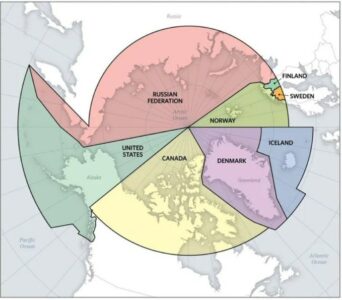The Arctic’s transformation into a geopolitical chessboard reflects the US/NATO Cold War reflexes, ill-suited to an emerging multipolar world.
Written by Uriel Araujo, PhD, anthropology researcher with a focus on international and ethnic conflicts
As the world fixates on the battlefields of Ukraine and the volatile Middle East, a quieter but no less consequential struggle is unfolding in the Arctic. Washington’s latest maneuver—planning to acquire icebreakers from Finland amid what some call an “Arctic crisis”—signals a bold escalation in the polar region in the context of competition with Beijing and Moscow.
This move, paired with the Danish Prime Minister Mette Frederiksen’s recent trip to Greenland, and President Donald Trump’s proposed energy sanctions targeting Russian liquefied natural gas (LNG) expansion (if he doesn’t change his mind), reveals a troubling pattern: once again, this has everything to do with the US-led NATO’s relentless push to encircle Russia, even at the risk of igniting a new geopolitical flashpoint (even if Trump seems to be “turning his back” to the Alliance).
The Arctic, far from being a frozen backwater, is poised to become the next major arena of U.S.-Russian contention—a development that exposes Trump’s America imperial ambitions and undermines claims of “isolationism” or of fostering peace and stability for that matter. Ironically, we now have an American president openly threatening (with annexation) the sovereignty of NATO European “ally”, Denmark, over the issue of Greenland.
The icebreaker deal with Finland is no mere logistical upgrade. Trump has framed it as a critical step “amid Arctic security concerns,” with Washington aiming to bolster its polar presence against Russia’s formidable fleet of over 36 icebreakers. One should pay attention also to the trilateral ICE Pact with Canada and Finland; expert Daniel McVicar (Research Director at White House Writers Group), predicts Trump will expand it to counter “Russian influence.”
Meanwhile, the Danish Prime Minister’s visit to Greenland, underscores Washington’s broader strategy to secure strategic footholds in the region. Greenland, a Danish territory, has long been a target of Trump’s fixation—he recently reiterated his desire to “get Greenland,” —a notion Russian President Vladimir Putin has called a “serious” U.S. intent. These moves are not about defense; they are about dominance.
Trump’s proposed energy sanctions, exceeding the scope of the 2019 measures, aim to choke Russia’s LNG ambitions, which are deeply tied to the Arctic. Russia’s Northern Sea Route, a thawing shipping lane along its Arctic coast, promises to redirect energy exports to Asia, circumventing Western chokeholds like the Suez Canal. By targeting this lifeline, the U.S. seeks to kneecap Moscow’s economic resilience—a tactic less about security and more about maintaining American hegemony. The region’s vast untapped resources, from oil and gas to rare earth minerals, only heighten the stakes. One may recall that the U.S. (then still under President Joe Biden, mind you) has already claimed a “huge portion of the ocean floor” from the Gulf of Mexico to the Arctic, a unilateral grab that flouts international norms and highlights the American expansionist ethos.
Increasingly warm temperatures in the Arctic region, which facilitate navigation, present a significant opportunity for the liquefied natural gas industry, among other benefits, hence the strategic importance of that area. Additionally (and relatedly), still during Biden’s administration, tensions have escalated in the Gulf of Finland. It’s worth noting that NATO’s further expansion under Biden, incorporating Sweden and Finland, has extended the Alliance’s territory all the way to Russia’s eastern Arctic flank (the Bering Strait), thus leaving Russia as the sole non-NATO country in the Arctic. This is the context for Trump’s Greenland and Arctic “obsession”.
NATO’s cheerleaders might argue that all of this is a necessary response to Russian “aggression.” After all, they claim, Moscow has militarized its Arctic frontier, with nuclear-powered icebreakers and new combat vessels like the Ivan Papanin. But this narrative conveniently ignores NATO’s own history of provocations. The alliance’s eastward creep—absorbing Finland and Sweden—has turned the Gulf of Finland into a potential “site of new conflict,” as I’ve written before.
Finland’s integration into the ICE Pact and its icebreaker expertise, means that the Nordic country, once a neutral asset, now serves NATO’s agenda—even when the incumbent American President is accused of “abandoning” the transatlantic alliance. This shift has strained Arctic cooperation, with Russia excluded from regional forums like the Arctic Council since 2022. Far from stabilizing the region, the United States actions are fracturing it.
The Greenland obsession epitomizes this overreach. Trump’s fixation, dismissed as eccentric in 2019, now aligns with a calculated NATO strategy, even while Trumps go as far as to threaten a member ally such as the Kingdom of Denmark. One may very well describe it as “part of a scramble for the Arctic,” (as Al-Jazeera called it) given Greenland’s strategic position astride key shipping routes and its mineral wealth.
Denmark is ramping up its Arctic defenses, yet its sovereignty over Greenland is increasingly a bargaining chip in Washington’s game. Putin’sremarks at an Arctic conference underscore Moscow’s alarm: the U.S. isn’t just eyeing territory—it’s projecting power into Russia’s backyard. This isn’t deterrence; it’s encirclement.
One must ask: who benefits from this Arctic gambit? Certainly not the global commons. The ICE Pact and sanctions risk escalating tensions in a region where cooperation—on climate, shipping, and resource management—once held promise. Even from an American perspective, Russia’s exclusion from Arctic dialogue pushes Moscow toward China (the exact opposite of what Trump supposedly is trying to achieve by means of a so-called “reverse Kissinger” strategy), in a context of a New Cold War, thereby forming a counter bloc that could destabilize the polar balance further. China’s “Polar Silk Road” ambitions, paired with Russia’s icebreaking prowess, challenge NATO’s aggressive dominance, yet the alliance’s response—more militarization, more sanctions—only deepens the divide.
The US presidential administration has released a promotional video about solidarity with Greenland and the confrontation between Russia and China on the Arctic continent
The Arctic should not be NATO’s next frontier. Its transformation into a geopolitical chessboard reflects the alliance’s Cold War reflexes, ill-suited to an emerging multipolar world. Trump’s icebreaker push and energy sanctions may bolster U.S. leverage, but they also invite retaliation—perhaps in the Gulf of Finland, or through Russia’s LNG pivot to Asia. To recap, the U.S. claims vast swathes of seabed, NATO tightens its grip on Greenland, and Finland’s shipyards churn out tools of confrontation. This isn’t security—it’s a recipe for conflict.
A saner approach would prioritize de-escalation: reintegrating Russia into Arctic forums, negotiating resource-sharing pacts, and curbing NATO’s northward sprawl. The Arctic’s future hinges on cooperation, not conquest. Yet as Washington doubles down, dragging its allies along, the ice grows thinner—both literally and figuratively. In fact, the next U.S.-Russian clash may erupt not in Ukraine or Syria, but rather in the frozen north, where NATO’s hubris could spark a fire no icebreaker can extinguish.
MORE ON THE TOPIC:







if you haven’t realised that wars the most profitable racket if all ,justifying “needing ” minerals iron ore wool oil science slaves into advanced technologies , healthcare space research everything else them you’re plain stupid. it’s common sense 101
if you can’t understand divide from within to conquer using commerce then you need retraining.
wake up .it’s class warfare.
you are showing the logical map. the one where you take the eastern and the westernmost point and triangulate to the north pole. it’s worse if you use the ‘u.s. map’. it uses bs geological survey to give greenland a generous chunk of land beyond the north pole. but yeah, you see why trump wants it.
more expansion again ? can we finally just call it ww3 because it is .